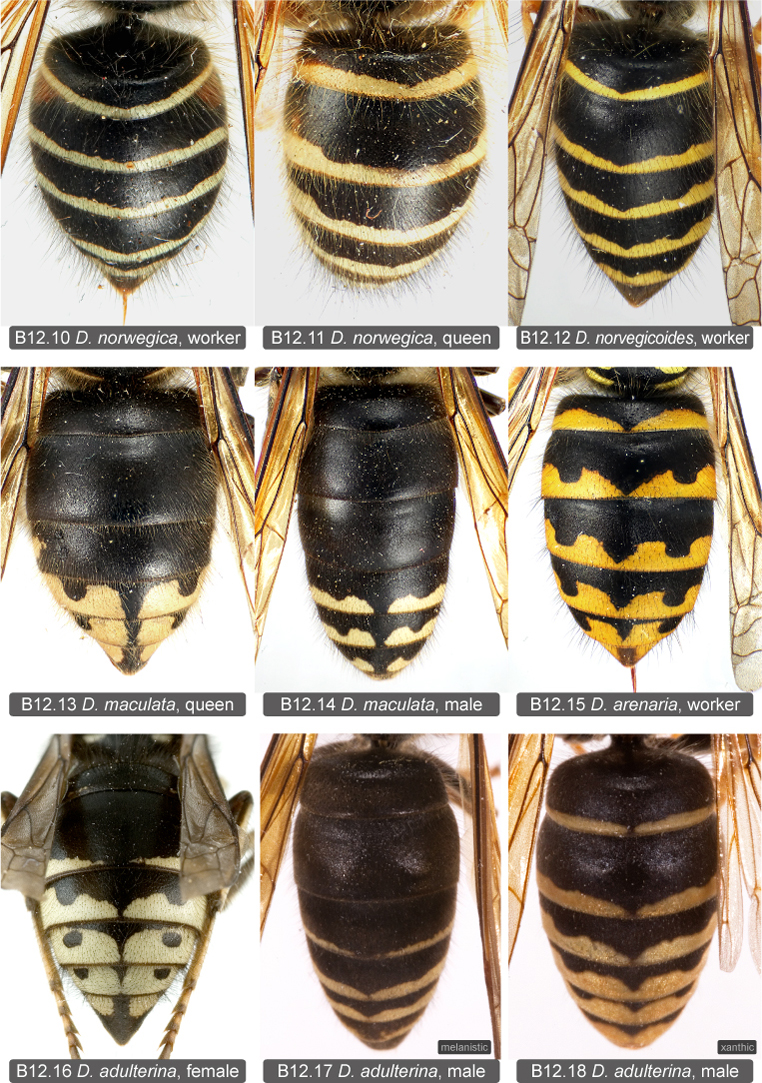
| Home | Table of contents | Keys | Species list | Glossary | Image data | PDF | Cite this article | Feedback | Updates |
Identification Atlas of the Vespidae (Hymenoptera, Aculeata) of the northeastern Nearctic region
CJAI 05, February 19, 2008
doi: 10.3752/cjai.2008.05
Matthias Buck, Stephen A. Marshall, and David K.B. Cheung
Department of Environmental Biology, University of Guelph, Guelph, Ontario, Canada N1G 2W1
Dolichovespula Rohwer
This genus includes 18 species and is distributed through the Holarctic and Oriental region. Six species occur in North America including five species in the northeast (Carpenter and Kojima 1997, Archer 1999).
References. – Archer, 1989 (key to World species); Akre et al., 1981 (key to Nearctic workers); Wagner, 1978 (key to Nearctic species); Miller, 1961 (key to Nearctic species).
12. Key to eastern Nearctic Dolichovespula species
| 1. | Metasomal terga 1 and 2 with pale apical fasciae well developed and not or hardly incised medially (Figs 12.10–12). Female (queens and workers) either with broadly interrupted pale postocular band (Fig. 12.2) or whole lower gena black (Fig. 12.1) | 2 |
| - | Metasomal terga 1 and 2 either completely black or with apical fasciae interrupted or deeply incised medially (Figs 12.13–14, 12.15, 12.16–18). Female usually with uninterrupted pale postocular band (Fig. 12.3) | 3 |
| 2. | Body with pale markings ivory; tergum 2 of males and workers usually with a pair of ferruginous blotches (Fig. 12.10). Female: lower gena black (Fig. 12.1) or with small pale spot whose (anteroposterior) width is less than 1.5x mid ocellar diameter. Male: at least flagellomeres VII-X with one tyloid (Fig. 12.4). Mostly subarctic and high boreal zones, rarely further south | D. norwegica (Fabricius) |
| - | Body with pale markings yellow; tergum 2 never with ferruginous markings (Fig. 12.12). Female: lower gena with larger pale spot whose width is greater than 1.5x mid ocellar diameter (Fig. C85.1). Male: at least flagellomeres VII-X with two tyloids (Fig. 12.5) | D. norvegicoides (Sladen) |
| 3. | Pronotum striate in ventral corner (Fig. 12.6). Terga 1–3 essentially black, without pale apical fasciae but tergum 3 usually with pale lateral spots (Figs 12.13–14; exceptionally terga 1 and/or 3 fasciate). Hind tibia black, at most with small pale spots near base and apex (Fig. C84.1). Male: apex of sternum 7 with a pair of pointed teeth (Fig. 12.7). Large species (fore wing length 11–18 mm) with ivory markings | D. maculata (L.) |
| - | Pronotum not striate in ventral corner. Terga 1–3 with pale apical fasciae (Figs 12.15–16, 12.18), in male sometimes evanescent or absent on terga 1 and 2 (Fig. 12.17). Outer surface of hind tibia largely pale. Male: apex of sternum 7 rounded, lacking teeth. Smaller species (fore wing length 9–14 mm) with yellow or ivory markings | 4 |
| 4. | Body with pale markings ivory* (Figs 12.16–18). Ocular sinus predominantly black, the black area extending to lower margin of sinus (Fig. 12.8). Flagellum black; apical flagellomeres of male without tyloids (but flagellomere XI sometimes with one tyloid). No worker caste (social parasite); female fore wing length 13.0–14.0 mm | D. adulterina (du Buysson) |
| *Note. In D. adulterina (especially queens) a yellow form occurs very rarely (this form is more common in western North America). The other characters given in this couplet will distinguish such specimens from D. arenaria. | ||
| - | Body with pale markings yellow (Fig. 12.15). Ocular sinus predominantly pale (Fig. 12.9) except in some subarctic specimens. Flagellum yellow ventrally; apical flagellomeres of male with two tyloids each (similar to Fig. 12.5). Worker caste present; female fore wing length usually 9.0–12.0 mm | D. arenaria (Fabricius) |
Metasoma of Dolichovespula species

| Home | Table of contents | Keys | Species list | Glossary | Image data | PDF | Cite this article | Feedback | Updates |
